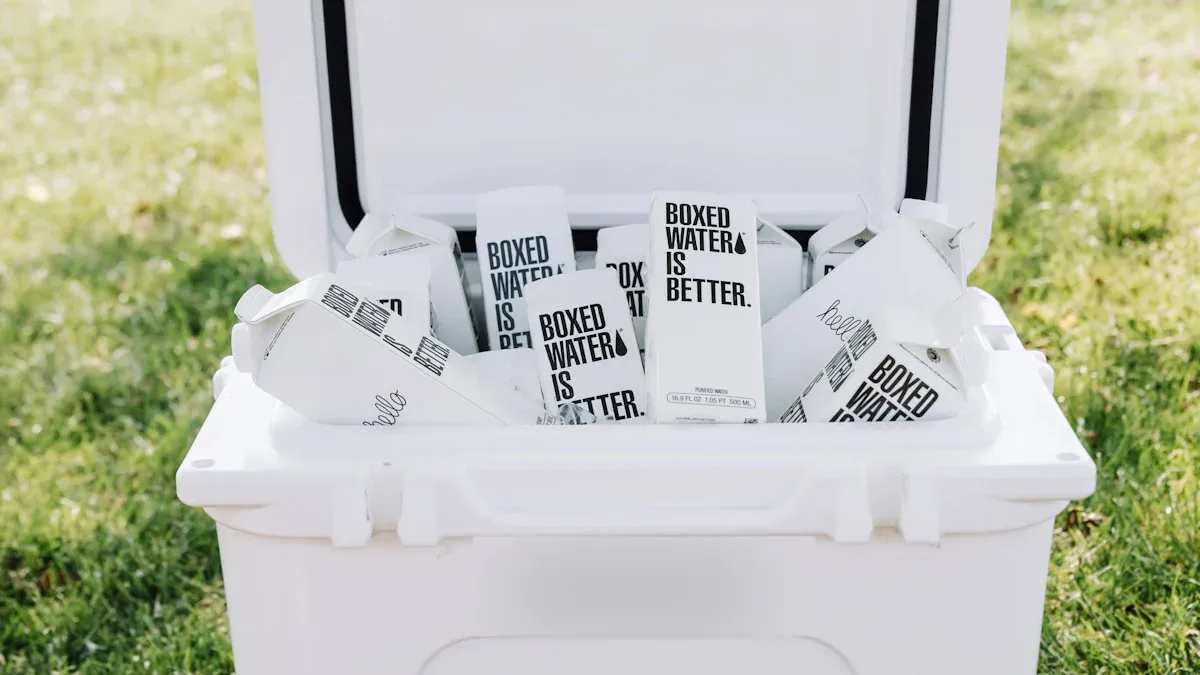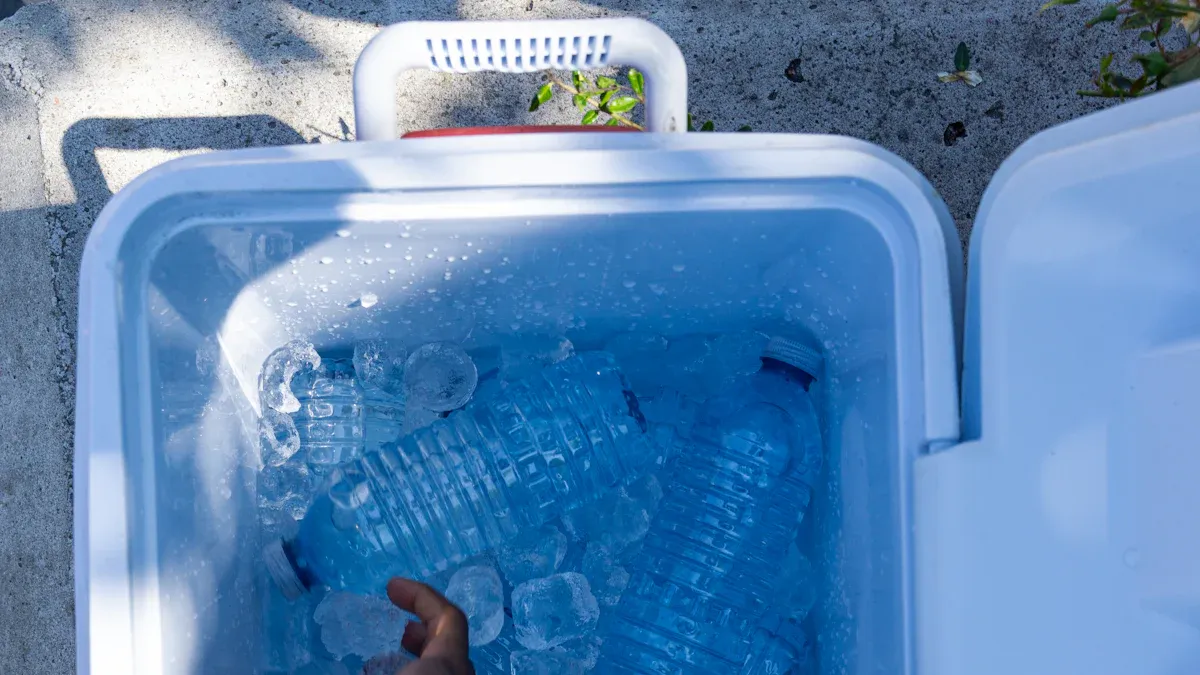

Taking care of your hard cooler lunch box isn’t just about keeping it clean. It’s also about ensuring it lasts longer and performs better. Proper maintenance can save you money and protect the environment. For instance, studies show that efficient cleaning practices reduce energy use by 10%, saving up to $59,000 annually. Plus, by preventing issues like corrosion and biofouling, you’ll use less water and energy. In 2025, modern innovations make this care even simpler, so you can keep your personal hard cooler and ice in top-notch condition with less effort.
Kuer, one of the leading cooler box manufacturers will provide you with a variety of cooler solutions.
Cleaning and Hygiene
Steps for How to Clean a Cooler
Cleaning your cooler doesn’t have to be a chore. With the right supplies and a simple routine, you can keep it fresh and ready for your next adventure. Follow these steps for how to clean a cooler effectively:
- Empty and Rinse the Cooler: Start by removing all contents, including leftover food and melted ice. Rinse the cooler with warm water to loosen any debris.
- Clean with Soap and Water: Mix a mild dish soap solution and scrub the interior and exterior with a soft brush. This helps remove dirt and prevent odors and bacteria buildup.
- Rinse Thoroughly: Use clean water to rinse away all soap residue. Repeat this step a few times to ensure no detergent remains.
- Dry Completely Before Storage: Air dry the cooler in a well-ventilated area. This step is crucial to avoid mold and mildew.
- Regularly Check for Mold and Mildew: Inspect your cooler periodically for any signs of mold. If you spot any, clean it immediately to maintain hygiene.
Pro tip: Always use gentle cleaning tools to avoid scratching the surface of your cooler. Scratches can trap bacteria and make cleaning harder over time.
How Often Should You Clean Your Cooler
You might wonder, “How often should you clean your cooler?” The answer depends on how frequently you use it. If you’re packing food and ice daily, wipe down the cooler after each use. This prevents odors and bacteria buildup and keeps your cooler hygienic. For occasional use, a thorough cleaning every few weeks should suffice.
Think of your cooler as an extension of your kitchen. Just like you wouldn’t leave dirty dishes sitting around, you shouldn’t let grime or leftover food linger in your cooler. Regular cleaning ensures it’s always ready for your next outing.
Removing Stubborn Stains and Odors
Sometimes, your cooler might develop stubborn stains or unpleasant smells. Don’t worry—there are effective solutions to tackle these issues. Here’s a quick guide:
| Method | Effectiveness Description |
|---|---|
| Probiotic Bacteria | Reduces malodorous microbial metabolites, keeping your cooler fresh. |
| Steam Stripping | Efficiently removes volatile organic compounds (VOCs) that cause bad smells. |
| PEG Extraction | Targets polar compounds to eliminate lingering odors. |
| Carboxen/PDMS Fiber | Achieves up to 85% removal of VOCs, making it ideal for tough odor problems. |
For stains, try a paste made of baking soda and water. Apply it to the affected area, let it sit for 15 minutes, and scrub gently. For odors, place a bowl of activated charcoal or coffee grounds inside the cooler overnight. These natural deodorizers absorb smells, leaving your cooler fresh and clean.
Tip: Avoid using harsh chemicals, as they can damage the cooler’s surface and affect its performance. Stick to eco-friendly solutions whenever possible.
Maintenance Tips
Store Your Cooler Properly
Storing your cooler the right way can make a big difference in how long it lasts. After every use, you should dry it completely before storage. This step prevents moisture from lingering, which can lead to mold or mildew. Once it’s dry, store your cooler in a cool, dry place away from direct sunlight. Prolonged exposure to UV rays can weaken the material and cause discoloration.
If you’re short on space, consider storing your cooler with the lid slightly open. This allows air to circulate and keeps odors from building up. You can also place a small sachet of baking soda inside to absorb any leftover smells.
Tip: Avoid stacking heavy items on top of your cooler. The weight can warp the lid or compromise the seal, reducing its cooling efficiency.
Prevent Mold and Mildew
Mold and mildew are the enemies of any cooler. To keep them at bay, you should regularly check for mold and mildew, especially if you use your cooler often. Start by cleaning it thoroughly after each use. Even small food particles or melted ice can create the perfect environment for mold to grow.
For an extra layer of protection, wipe down the interior with a solution of water and white vinegar. Vinegar is a natural disinfectant that helps kill mold spores. Let the solution sit for a few minutes before rinsing it out. Then, dry the cooler completely before storage.
If you notice any musty smells, don’t panic. Fill the cooler with a mixture of warm water and baking soda, let it soak for an hour, and then rinse it out. This simple trick can neutralize odors and leave your cooler smelling fresh.
Note: Always inspect the gasket around the lid. A damaged gasket can trap moisture, making it easier for mold to grow. Replace it if you see any cracks or wear.
Quick Fixes for Wear and Tear
Even the best coolers can show signs of wear over time. But you don’t always need to replace them. Quick fixes can help you maintain a cooler and extend its lifespan. For example, if the hinges or latches become loose, tighten them with a screwdriver. If they’re broken, most manufacturers sell affordable replacement parts.
Upgrading your cooler’s insulation can also reduce wear and tear. Modern refrigeration systems are designed to minimize strain on the cooler’s components, which helps them last longer. Plus, some upgrades may qualify for utility incentives, making them a cost-effective choice.
For minor scratches or dents, use a plastic repair kit to restore the surface. These kits are easy to use and can make your cooler look almost new. And if the seal around the lid isn’t as tight as it used to be, applying a food-safe silicone lubricant can improve its performance.
Pro Tip: Always keep a small repair kit handy. It’s a lifesaver for quick fixes during camping trips or outdoor events.
Optimization for Use
Efficient Packing Tips
Packing your cooler efficiently can make all the difference in keeping your food fresh and your ice lasting longer. Start by planning ahead. Place frozen water jugs at the bottom of the cooler. These act as a solid base and keep everything colder for longer. Next, pack a cooler with layers. Put frozen items like meat or pre-cooked meals directly on top of the ice. Then, add perishable food like fruits and sandwiches. Finally, place snacks or drinks you’ll grab often at the top.
Keep everything organized by using resealable bags or containers. This prevents spills and keeps food dry. If you’re packing for a long trip, consider using two coolers—one for food and one for drinks. Opening the cooler frequently for drinks can cause ice to melt faster.
Here’s how different packing methods compare in thermal performance:
| Time (hours) | Ozark Trail Cooler Ice Remaining | Polar Bear Cooler Ice Remaining |
|---|---|---|
| 24 | About half melted | About half melted |
| 36 | 1/4 remains | 1/4 remains |
| 48 | A few individual pieces | More ice remains |
Tip: Always pre-chill your cooler before packing. Add ice or frozen water jugs a few hours before loading food to maximize cooling efficiency.
Best Cooling Techniques
Keeping your cooler cold isn’t just about adding ice. It’s about using the right techniques. Start by using block ice or frozen water jugs instead of crushed ice. Blocks melt slower and keep the cooler colder for longer. You can also use frozen food as an additional cooling source.
Another trick is to fill any empty spaces in the cooler with ice packs or frozen water bottles. Air gaps can cause ice to melt faster. If you’re heading out for a multi-day trip, consider using dry ice. It stays frozen longer and doesn’t leave a watery mess behind.
Keep your cooler in the shade whenever possible. Direct sunlight speeds up ice melting. If you’re camping, cover the cooler with a reflective blanket to reduce heat absorption.
Pro Tip: Avoid draining melted ice unless absolutely necessary. The cold water helps maintain the cooler’s temperature and slows down ice melting.
Avoiding Common Cooler Mistakes
Even seasoned outdoor enthusiasts make mistakes when using a cooler. One common error is overpacking. Stuffing your cooler too full reduces airflow, making it harder to keep food cold. Leave some space for ice packs or frozen water jugs to fill gaps.
Another mistake is forgetting to seal food properly. Loose items can leak and create a mess. Always use airtight containers or bags. Also, avoid opening the cooler too often. Every time you lift the lid, warm air enters and melts the ice faster.
Don’t forget to check the cooler’s seal. A damaged gasket can let cold air escape, reducing efficiency. If you notice the lid isn’t closing tightly, apply a food-safe silicone lubricant or replace the gasket.
Note: Never store your cooler in direct sunlight or a hot car. High temperatures can weaken the material and reduce its cooling performance.
Advanced Care for 2025
Eco-Friendly Cleaning Solutions
Caring for your cooler doesn’t have to harm the planet. In 2025, eco-friendly cleaning solutions make it easier than ever to keep your cooler spotless while protecting the environment. You can swap harsh chemicals for natural alternatives like vinegar, baking soda, or plant-based cleaners. These options clean effectively without leaving harmful residues behind.
Reusable cleaning tools, like microfiber cloths, are another great choice. They’re gentle on your cooler’s surface and reduce waste compared to disposable wipes. For stubborn stains or odors, try soaking your cooler with a mix of warm water and lemon juice. This simple trick removes grime and leaves your cooler smelling fresh.
Tip: Always rinse thoroughly after using eco-friendly solutions to ensure your cooler stays safe for storing food.
Innovations in Cooling Technology
Coolers in 2025 are smarter and more efficient than ever. Companies like Honeykomb and Pelican Products have introduced cutting-edge designs that revolutionize how you keep food cold. For example, vacuum coolers use patented insulation technology to improve cold retention and reduce bacteria growth. Portable lunchbox coolers now feature integrated ice packs and compact designs, making them perfect for daily use.
Here’s a quick look at some of the latest innovations:
| Innovation Type | Description | Company | Date |
|---|---|---|---|
| Vacuum Cooler | Utilizes patented vacuum technology to improve insulation and reduce bacteria growth. | Honeykomb | August 2023 |
| Portable Lunchbox Cooler | Compact design with superior cold retention and integrated ice pack. | Pelican Products | November 2022 |
These advancements don’t just keep your food colder for longer—they also make coolers easier to clean and maintain.
Sustainable Practices for Cooler Longevity
Want your cooler to last for years? Sustainable practices are the key. Start by using your cooler responsibly. Avoid overloading it with heavy items that could damage the lid or hinges. Instead, pack food and ice strategically to maximize efficiency.
Regular maintenance also plays a big role. Clean your cooler after every use and store it in a cool, dry place. If you notice wear and tear, repair it instead of replacing it. Many manufacturers offer replacement parts for hinges, latches, and gaskets, so you can keep your cooler in top shape without creating waste.
Pro Tip: Invest in coolers made from durable, recyclable materials. They’re built to last and better for the environment.
Taking care of your cooler lunch box hard keeps it clean, durable, and ready for every adventure. Modern solutions in 2025 make maintenance easier than ever. By following these tips, you’ll save money and extend your cooler’s life. Start today and enjoy a reliable cooler lunch box hard for years to come!
FAQ
How do I know if my cooler needs repairs?
Check for loose hinges, cracked seals, or warped lids. These signs mean your cooler might need quick fixes or replacement parts.
Can I use dry ice in my cooler lunch box?
Yes, but handle it carefully. Dry ice keeps items colder longer and doesn’t leave water behind. Always follow safety guidelines when using it.
What’s the best way to pre-chill my cooler?
Add ice or frozen water bottles a few hours before packing. This lowers the cooler’s temperature and improves its cooling efficiency.




